Archive for June 2012
You Don’t Need a TCEQ To Know Which Way the Wind Blows
Flare at XTO gas treating facility in Freestone County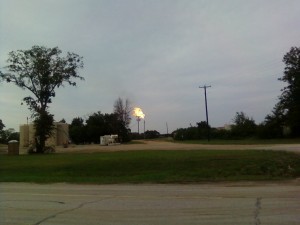
Dallas lies directly downwind of Freestone County during DFW's ozone season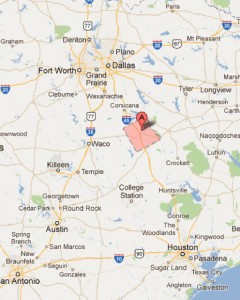
For their "study," the TCEQ was comparing a site in Parker County that was their "Barnett Shale" air monitor, with a "non-Barnett Shale" monitor at Eagle Mountain Lake.
Now you have to understand that in 2009, the area around the EML monitor looked like Spindletop circa 1901, with derricks spotting the landscape in all directions, including for miles and miles east and south of the Lake, which is in northwest Fort Worth. The idea that this monitor was "relatively unaffected" by gas industry emissions was laughable to anyone who'd actually been on the ground and visited the site. But this staffer clearly hadn't set foot outside of Austin except to come here and give this reassuring briefing.
And the TCEQ's logic went like this: Since the predominant winds during "ozone season" go from southeast to northwest, and since all of the gas emissions from the Shale were clearly "west" of DFW, there was no way that gas mining emissions impacted Metromess air quality.
When it was pointed out that there was plenty of drilling on the eastern and southern sides of the EML monitor, the staffer replied that the "majority" of Shale emissions were north and west of the metropolitan area.
It was a ridiculous argument then and even more so now, given how far east and south gas mining as advanced. There's active drilling and processing in seven of the 10 "non-attainment counties (Dallas, Denton, Ellis, Johnson, Tarrant, Parker, and Wise). The rigs have marched east along I-30 and I-20, from Weatherford to Ft. Worth to Arlington to Grand Prairie. Now the city of Dallas is re-writing its gas drilling ordinance in response to a new wave of requests to drill further east. There's no question that many ozone monitors that had no gas sources around them 10 years ago are now either surrounded and/or downwind of gas sources of air pollution in 2012.
And yet, this "gas pollution isn't in the right location to impact DFW air quality" argument is still being used by the TCEQ to avoid more pollution controls on gas sources within the now-10 county DFW "non-attainment" area for smog.
Compressor Station in Freestone County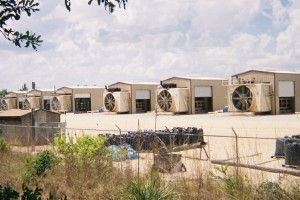
Hold on, Arlington may be in the thick of it, but Dallas isn't downwind of gas sources, is it?
Yes it is.
For one thing, you have drilling and processing and injection wells in northern Ellis County, and their pollution is as likely to impact Dallas air quality, just as the Midlothian cement plants, located in the same vicinity, have been doing for decades.
But you may not be aware of the huge amount of pollution coming from gas sources in places southeast – and upwind – of Dallas like Freestone County, otherwise known to clean air activists as the home to the dirty ol' Big Brown lignite coal-fired power plant.
Big Brown has earned a reputation for being an environmental disaster that lacks modern controls. It puts a lot of bad stuff in the air, up to 6,8,00 tons a year of smog-forming Nitrogen Oxides (NOx). That's approaching half a million cars' worth of air pollution right there. And that's why it's important to keep pressing Big Brown and all the other East and Central Texas power plants upwind of DFW to modernize and reduce emissions.
But here's the thing. Even though Freestone County isn't in the Barnett Shale, it's in the Haynesville Shale play of East Texas. It now has as many gas wells (approx. 3000) within its borders as Tarrant County – the epicenter of the Barnett. It also has a lot of gas pipelines running through it. Those pipelines need compressors to keep them running. Consequently, Freestone County has a lot of compressors. 130 of them according to the TCEQ, up from 69 just three years ago. Each of these large line compressors can be permitted by rule – meaning its automatic and not open for public discussion – for up to 250 tons per year of Nitrogen Oxide pollution and 25 tons of Sulfur Dioxide and other kinds of pollution.
This is a citizen's map of all the gas compressors in Freestone County...in 2009. There are twice as many now according to the TCEQ.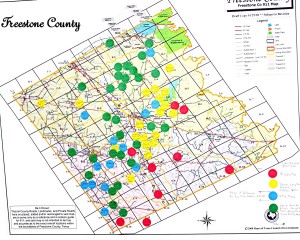
Gas compressor permits in Freestone County represent the equivalent of 4. 7 Big Brown coal plants worth of NOx pollution. Every year.
Big Brown is actually being forced to reduce its emissions of NOx. It's switching from burning lignite coal to the "good stuff" from Wyoming and adding more controls. Compressors? Not so much. Their proliferating throughout the state with no accountability of how they will impact air quality – including non-attainment areas downwind.
Now add the phenomena that the Denver air quality folks have identified of already dirty air being able to turbocharge gas patch air into ozone pollution more quickly, and you have a large and potent pollution "front" blowing in from the southeast toward DFW to meet the prodigious amount of smog being generated in the central city.
That might explain why a monitor at Mockingbird and I-35 – on the eastern side of DFW – that hasn't tripped in seven years has done so again this summer.
June Smog Attack: Day 3
 High ozone levels continued to take their toll on people and monitors Wednesday. Grapevine joined the Hinton Street Dallas monitor in recording its fourth "exccedence" of the old 1997 85 ppb smog standard and so establishing an official violaiton of it.
High ozone levels continued to take their toll on people and monitors Wednesday. Grapevine joined the Hinton Street Dallas monitor in recording its fourth "exccedence" of the old 1997 85 ppb smog standard and so establishing an official violaiton of it.
This is an 8-hour standard wherein the average over eight hourly readings must be 85 or above, So we're not talking about short-term spikes. These are day-long spikes.
Monitors in Keller, Eagle Mountain Lake, Arlington, North Dallas and the Redbird area of southwest Dallas saw their third exccedence of the 85 ppb standard, meaning one more day of bad smog could also make them environmental crime scenes. Midlothian, Northwest Ft. Worth, and Frisco all have two exceedences as of yesterday,
We're going to wait until there's a pause in the bad news to look at how off the mark the all powerful and holy TCEQ computer model is so far, but suffice to say that after this week, there's not likely to be any monitor inside the nine-county area that will even be close.
Unacceptable
 On Monday, the Obama Administration announced that it was re-writing new pollution rules for cement plant pollution on the eve of their implementation, including delaying compliance by two years, almost doubling the soot pollution standard, and giving up trying to monitor that pollution in real time.
On Monday, the Obama Administration announced that it was re-writing new pollution rules for cement plant pollution on the eve of their implementation, including delaying compliance by two years, almost doubling the soot pollution standard, and giving up trying to monitor that pollution in real time.
This is an unacceptable rollback in emission rules that Downwinders and is supporters have been fighting for since the mid-1990's and we must organize now to show the EPA they have no popular support at all.
North Texas is one of the regions that will be most affected by EPA's retreat. Midlothian hosts the largest concentration of cement plants in the US, with three huge plants owned by TXI, Holcim, and Ash Grove operating a total six kilns, or furnaces within a few miles of each other. All three have permits to burn used tires and other industrial waste besides coal. They are the largest stationary sources of air pollution in North Texas, emitting hundreds of thousands of tons annually.
Finalized in August 2010, and on the eve of being made into law with a deadline of 2013 to comply, the new EPA emission rules were projected to prevent between 960 and 2,500 premature deaths, 1,500 non-fatal heart attacks, and 17,000 cases of aggravated asthma EVERY YEAR.
By EPA's own estimate, the two-year delay until 2015 would cause between 1,920 and 5,000 avoidable deaths, 3,000 non-fatal heart attacks, and 34,000 cases of aggravated asthma. Since we have more cement plant capacity than any other part of he country, we'll probalby be absorbing a disproprotional share of that harm.
The delay in compliance from 2013 to 2015 is bad enough, but the EPA is also proposing to raise the Particulate Matter emissions rate for existing plants from .04 pounds of manufactured cement to .07 and it's scrapping requirements to monitor PM pollution in real time and instead substituting a controlled test burn every three years.
PM is used as a surrogate for toxic metals like Mercury, Lead and Cadmium. It's one of the most insidious and dangerous pollutants there are. The EPA just lowered the national ambient air standard for PM pollution based on the medical literature linking even very low levels of the pollution to a variety of health effects, including heart attacks, strokes and brain damage.
EPA has given cement plants a free pass – with only one test every three years to prove they're meeting a daily standard. This is like trying to control speedy drivers with a radar gun test every three years – and you know exactly where and when the radar gun will be pointing at you.
Concurrent with the EPA's announced plan to weaken and delay its clean air standards for cement plants, the agency also announced that a variety of industrial wastes such as tires, treated wood, plastic and chemical solvents do not meet the agency's new definition of "solid waste." That will mean cement plants like those in Midlothian can burn these kinds of industrial wastes without having to meet more stringent requirements under the Clean Air Act that were designed to limit the additional amount of dangerous pollution that results from their incineration.
The EPA issued the proposed changes under a court settlement with the Portland Cement Association. However, that case was decided more than six months ago in a unanimous decision by the United States Court of Appeals for the District of Columbia Circuit. Nothing in the Court's decision requires that the agency's rules for cement plants must be weakened or delayed in any way. Numerous attempts by industry lobbyists to weaken and delay the rules in Congress were ultimately voted down. After two decades of trying to get the EPA to follow the Clean Air Act, citizens thought they had overcome their final hurdle.
What the cement industry, radical House Republicans, and the courts could not do over the last two decades, EPA is trying to accomplish on its own just as this proposal was about to be implemented.
This is what makes these changes so senseless. EPA seems to be going out of its way to kowtow to the cement industry when it doesn't have to, and when the vast majority of citizens over the last 20 years have urged it not to. Many of you will remember that one of only three national hearings on the rule in September 2009 took place at the DFW Airport Hotel and drew over 200 people. Every speaker, save for less than a half dozen industry representatives, were supportive of strong emission limits for cement plants.
Downwinders at Risk was one of the original plaintiffs that went to court in the 1990's and early 2000's to challenge weak Clinton Administration rules for cement plants that were eventually overturned. It's been a major force in rallying public support for better regulation of cement plant pollution since its founding in 1994. And we're not stopping now.
Please send comments to EPA on these new rules. Click and submit the prepared comments we have at our website, or write your own using the same click and comment tool, but please make sure your voice is added to the thousands of others that we need to send EPA a strong message of disapproval. EPA is hoping this is a niche issue that you don't care about. Please prove them wrong.
Happy Ozone Non-Attainment Day!
 Ozone Non-Attainment Day is a traditional annual DFW event. Every summer there's a day when one or more air quality monitors records its fourth "exceedence" of whatever national ozone standard the region is violating. Then and only then does the monitor officially violate the Clean Air Act and put DFW in "Non-Attainment" of clean air once again.
Ozone Non-Attainment Day is a traditional annual DFW event. Every summer there's a day when one or more air quality monitors records its fourth "exceedence" of whatever national ozone standard the region is violating. Then and only then does the monitor officially violate the Clean Air Act and put DFW in "Non-Attainment" of clean air once again.
Gifts of inhalers, oxygen tanks, and emergency room visits are often exchanged by family members and friends on and around the actual day of Non-Attainment.
This year Governor Perry and the Texas Commission on Environmental Quality made sure our Ozone Non-Attainment Day arrived extra early. Usually, we don't see it come until August. In fact, ever since ozone monitoring began in 1997, there's only been one other year when it came as early as this year.
In 2006, we had Non-Attainment day on June 14th. Boy, that was a doozy of a summer – 12 out of 19 monitors eventually tripping. Think this one might be as big? It's sure possible.
One sign is that the monitor that triggered this year's Non-Attainment Day is the historic Hinton Street site near Mockingbird and I-35. This particular monitor hasn't even recorded a violation of the Clean Air Act since 2005 – so welcome back Hinton Street! But this site has a long and storied Non-Attainment history. The Hinton Street monitor recorded violations for five years straight during some of the worst smog pollution DFW has ever seen, from 2000 to 2005, with some of those years seeing 14 out of 18 monitoring sites recording violations.
So Hinton Street monitor violations are associated with really bad air. So are Non-Attainment Days that arrive in June. We could have one long hellacious summer ozone pollution episode ahead of us this year. Maybe even a return to double-digit monitors in violation. Isn't it exciting?
You may want to send Non-Attainment Day greetings to Governor Perry and TCEQ Chair Bryan Shaw, since it was their idea of watching people buy newer cars as a pollution control strategy, along with ignoring the large increase in smog-forming pollution from the natural gas industry, that made this June Non-Attainment Day possible. (Downwinders reminds you to please breathe responsibly).
Wastes Waiting to Be Burned in Kiln Ignite Unauthorized Fire
What local news reports called a "massive fire" swept through the piles of industrial wastes waiting to be burned at the Argos Cement Plant in Harleyville South Carolina yesterday. Ten workers escaped injury, but the fire was so intense that it required the assistance of outside fire departments totaling 75 firefighters, three trucks and two aircraft, and lasted all day as crews snuffed out hot spots.
Starting at about 5 in the morning, the fire quickly engulfed the 60 by 100 foot warehouse stuffed with carpet pieces, paper, and rubber ready to be put into the cement kiln as "fuel." Imagine a landfill or tire fire and that's the kind of heat, smoke and toxicity you've got to deal with when your "recycled fuel" goes up in flames.
Of course, health officials denied there was any risk of exposure to toxic fumes even as they were still trying to determine exactly what was in the warehouse. That's the deductive reasoning process in action when it comes to local officials in company towns. Harleyville is home to the second-largest concentration of cement manufacturing in the country, behind only Midlothian. It hosts two large plants – Argos and Giant. It's also been a center of kiln waste-burning since the 1980's
The kinds of wastes that caught fire in South Carolina are among those that TXI now has a permit to burn in its Midlothian cement plant, along with car interiors and plastic garbage. A permit that did not offer any public comment or hearing opportunity. The Ash Grove and Holcim Midlothian cement plants also burn industrial wastes including tires and used oil. In the mid-1990's a tire "recycling" firm in Midlothian connected to the cement plants caught fire and burned for days with the black smoke wafting through downtown Dallas skyscrapers.
New Evidence of Ozone Health Harms in the Air You’re Breathing This Week
 As of 10 am on Tuesday, air quality monitors in Grapevine, Midlothian, Frisco and the Redbird area of Dallas had already recorded "Level Orange" concentrations of smog, including a 106 ppb reading in Grapevine. As late as 9 pm last night, ozone levels were still in the 90's in Weatherford. It's going to be another long, hot day of bad air throughout the DFW area. Which means they'll be people suffering form breathing that bad air. Today there's new evidence that that suffering includes heart attacks and strokes caused directly by ozone pollution.
As of 10 am on Tuesday, air quality monitors in Grapevine, Midlothian, Frisco and the Redbird area of Dallas had already recorded "Level Orange" concentrations of smog, including a 106 ppb reading in Grapevine. As late as 9 pm last night, ozone levels were still in the 90's in Weatherford. It's going to be another long, hot day of bad air throughout the DFW area. Which means they'll be people suffering form breathing that bad air. Today there's new evidence that that suffering includes heart attacks and strokes caused directly by ozone pollution.
EPA Toxicologists at Research Triangle, North Carolina exposed willing subjects to clean air, or to air containing 0.3 parts per million ozone. On the high-ozone day, volunteers inhaled the same cumulative dose that they would have received over eight hours in a place that exceeded the U.S. federal limit of 75 parts per billion for that length of time. Just like we've been doing here in DFW for the past three days. The results of the study showed ozone is causing acute — and even chronic — risk for heart attacks in the people who breathe it.
Blood levels of inflammatory agents increased, sometimes even doubling, after the subject's ozone exposure, and this increase could last more than a day. High ozone exposure also triggered subtle changes in heart rate variability, indicating a higher risk of arrhythmias. Ozone also altered levels of several proteins involved in blood clotting.
A decade ago the head of the Texas environmental agency stated that Ozone was a "benign pollutant" and argued against lowering the national standard for exposure to it. Last year, Texas state government again fought a lowering of the ozone standard, saying there was no proof of harms at levels below 85 parts per billion despite an independent panel of scientists saying there was. The more we know about how ozone impacts the human body the more we see that even levels considered "safe" a few years ago have far-reaching harmful effects.
75, 85, 105 parts per billion. These are just numbers from monitors. Behind them are real people having asthma attacks, heart attacks, and strokes. This is why it's important to win the battle with DFW's chronic smog. This is why it's a public health issue that's too important to be left up to a group of political appointees in Austin beholden to industry that too often pretends there's not even a problem.
CDC Issues Health Alert on Silica in Fracking
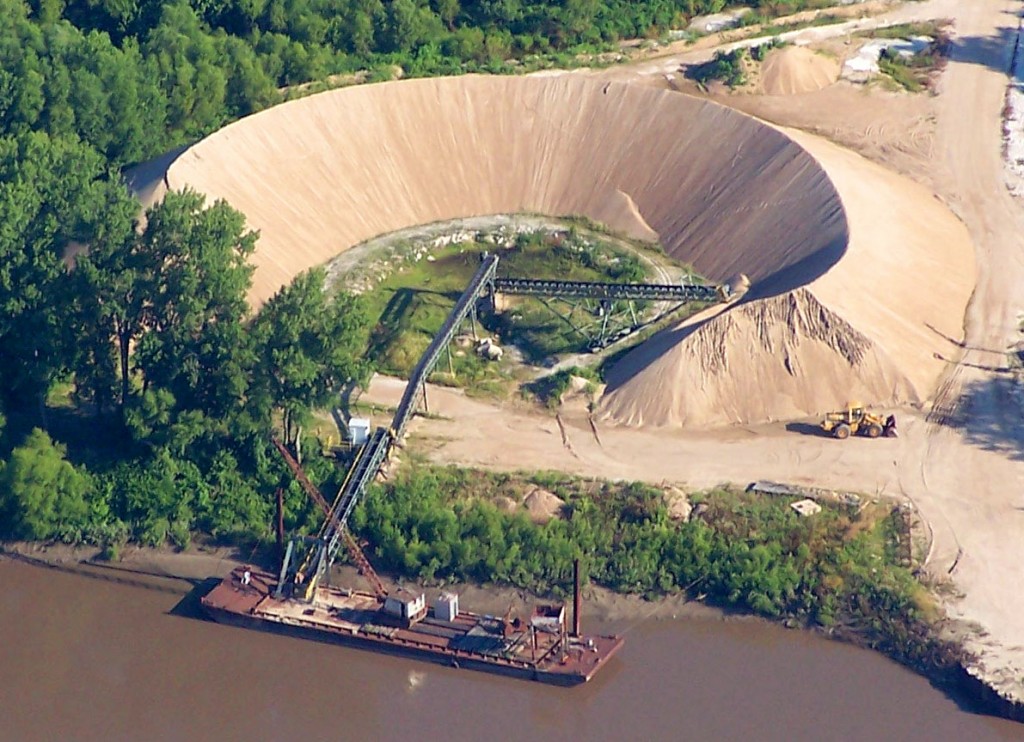 Last Thursday an arm of the Centers for Disease Control issued a "Hazard Alert" concerning exposure to Silica pollution at fracking drilling site. This comes after nationwide tests by the National Institute for Occupational Safety and Health at 11 well pads showed alarmingly high Silica levels in the air.
Last Thursday an arm of the Centers for Disease Control issued a "Hazard Alert" concerning exposure to Silica pollution at fracking drilling site. This comes after nationwide tests by the National Institute for Occupational Safety and Health at 11 well pads showed alarmingly high Silica levels in the air.
Silica is tiny sand particles. Breathe too many of them and you get Silicosis, a disease that literally suffocates you to death by putting down a layer of cement between you and your alveoli.
All the tests were at and around the drilling pad sites, not off-site, so we don't know what kind of hazard Silca pollution poses to surrounding residents. But the levels were so high at the pads that it's hard to believe it's never a factor. Reportedly, the amount of sand being used in fracking has significantly increased over the last decade.
For people west of DFW, that means more sand mining, and sand mining pollution in the Brazos and Red River valleys. For people near drilling sites, it could mean more air pollution nobody was trying to inventory until now.
Silica pollution wasn't even an issue of concern with fracking until somebody at the NIOSH decided to go looking for it. Who knows how many other fracking hazards are waiting to be discovered?
“Air Pollution Warning: Level Red”
 Monday turned out to be the single worst day for smog in DFW in 2012. Monitors in Northwest Ft. Worth, Grapevine, North Dallas and Dallas/Hinton Street recorded 8-hour averages of "Level Red" ozone – a level of pollution according to the Texas Commission on Environmental Quality that means,
Monday turned out to be the single worst day for smog in DFW in 2012. Monitors in Northwest Ft. Worth, Grapevine, North Dallas and Dallas/Hinton Street recorded 8-hour averages of "Level Red" ozone – a level of pollution according to the Texas Commission on Environmental Quality that means,
"The highest measured levels of ozone during the previous hour are considered unhealthy. Everyone, especially children, should limit prolonged outdoor exertion. People with respiratory disease, such as asthma, should avoid prolonged outdoor exertion."
Ten monitors exceeded the old 1997 eight-hour 85 ppb standard and those same three – Ft. Worth Northwest, Hinton and Arlington Airport, averaged over 100 ppb for eight hours or more.
In fact, Arlington saw a one-hour high of 128 ppb – an "exceedence" of a standard more than 20 years old – and it's 107 8-hour average on Monday was the highest at any DFW monitor since 2007.
The Hinton Street monitor recorded it's third exceedence since March. One more and DFW will once again be in non-attainment with the Clean Air Act, for the 21st year in a row. Four others recorded their second exceedence.
Last year it took us into the middle of Summer before that happened. This year it may occur during the first week of Summer. This is what Governor Perry and TCEQ call progress.
Burmuda Grass Strain Off-Gassing Cyanide
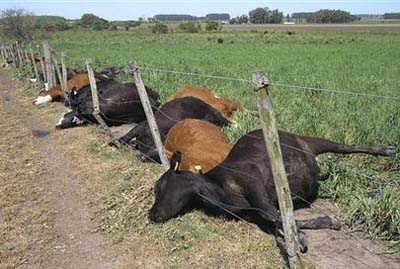 Not many stories can startle you these days. But this one will. It's right out of one of those cheesy mid-70's eco-themed diatribes where Mother Nature finally gets her revenge for all the abuses heaped on her by humankind.
Not many stories can startle you these days. But this one will. It's right out of one of those cheesy mid-70's eco-themed diatribes where Mother Nature finally gets her revenge for all the abuses heaped on her by humankind.
Only this isn't a movie. It's real: a hybrid strain of Bermuda grass hypernized strain used in pastures across the Southwest is off-gassing cyanide and killing cattle in Elgin, Texas.
"When our trainer first heard the bellowing, he thought our pregnant heifer may be having a calf or something," said Abel. "But when he got down here, virtually all of the steers and heifers were on the ground. Some were already dead, and the others were already in convulsions."
Within hours, 15 of the 18 cattle were dead.
"That was very traumatic to see, because there was nothing you could do, obviously, they were dying," said Abel.
The exact cause is unknown, but the source is not. It's a commonly used strain of Bermuda grass called Tifton 85 that's been around for 15 years. But it hasn't gone through a record-breaking drought, and some scientists think the stress might have had unforeseen consequences.
"Coming off the drought that we had the last two years … we're concerned it was a combination of events that led us to this," Dr. Gary Warner, an Elgin veterinarian and cattle specialist who conducted the 15 necropsies, told Kelly.
What is more worrisome: Other farmers have tested their Tifton 85 grass, and several in Bastrop County have found their fields are also toxic with cyanide. However, no other cattle have died.
Scientists at the U.S. Department of Agriculture are dissecting the grass to determine if there might have been some strange, unexpected mutation.
Will Dallas Council Listen to the Dallas Morning News?
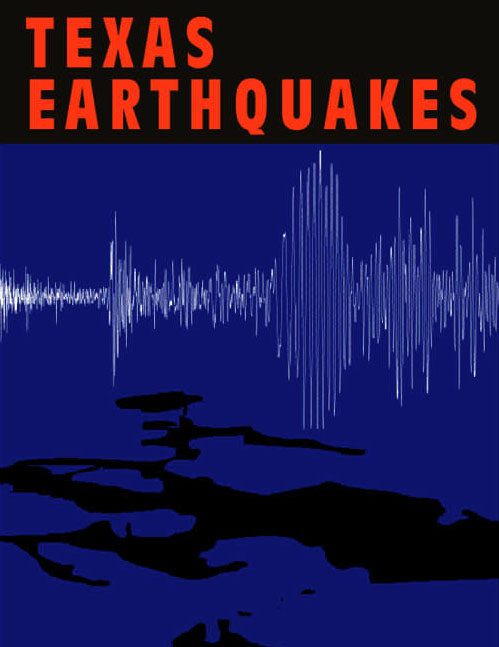 Today's editorial in the Morning News on Injection wells is a good one, although you'd like it to add the lack of any good waste disposal options for billions of gallons of contaminated fracking fluid to the reasons not to allow fracking at all.
Today's editorial in the Morning News on Injection wells is a good one, although you'd like it to add the lack of any good waste disposal options for billions of gallons of contaminated fracking fluid to the reasons not to allow fracking at all.
At its core, the argument is whether it's fair for a city like Dallas to make a profit from gas drilling while banning the logical results of that drilling to rural areas where residents there must bear a disproportional risk of earthquakes and other hazards.
But if the Dallas City Council was looking at a short way to describe its job of writing a new gas drilling ordinance in August, this is a pretty good candidate:
"…increase setbacks of drilling operations from schools, churches, other buildings and levees, regulate the use of water during drought conditions and ensure that drilling operations don’t worsen air quality."
There were already plenty of reasons to be cautious about frackign anywhere, but it's the fact that new hazards are being "discovered" at a quickening pace that should be of equal concern.
Earthquakes from injection wells wasn't even a topic of concern two years ago and now it's becoming a scientific consensus. Silica pollution was an unknown danger until recent testing showed levels of it off the charts at fracking sites. It's all the things we don't know yet about the consequences of fracking that should give any official pause before allowing it close to people or valuable natural resources. Injection wells is just one example of that unknown.
